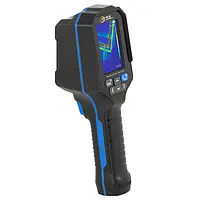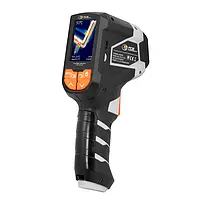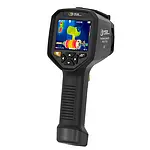First of all, before purchasing a thermal imager, it is necessary to clarify for which application the measuring device is to be used for. Thermal imager with a lower resolution should not be used for precise temperature measurement. Thermal imager with a VGA resolution could be used for easy temperature control, but practically, this does not make sense, since the devices of this kind has not been designed for such an application.
What resolution is required for which application?
Low resolution, for example, 38x38 pixels: Thermal imager with a very low resolution as the PCE-TC 28 are used for simple temperature tests. The cameras almost replace a pyrometer. They are a better infrared thermometer with the advantages of a real thermal imaging camera. The measuring instrument can be perfectly applied to test the temperatures of fuses and electrical assemblies in control cabinets. Or also for simple and point temperature measurements. Furthermore, these thermal imager can also be used for the rapid control of water pipes, pumps, bearings and gearboxes. Many of these thermal imeger have a SD card memory, so images and videos can be stored for documentation purposes.
160 x 120 pixels medium resolution: Thermal imager with a resolution of 160x120 pixels can be used for more demanding measuring tasks. With these thermal imaging cameras the thermal bridges on buildings can be searched and found, or the component temperature can be measured in the electronics development.
Thermal imager with a high resolution: for the infrared cameras of this class the thermal resolutions starts from 640x480 pixels, what corresponds to the default VGA-resolution. Also these thermal imager also have documentation possibilities. Due to the high pixel density, much better thermal images can be recorded. Thus, a much better picture quality is achieved.
Is a real image required?
Some thermal imager offer the possibility to record a visual real image in addition to the IR image. This means nothing else but that the camera can record the images in the visible spectrum and in the infrared spectrum. Cameras with a second real-image camera offer the user the possibility to place the infrared image continuously or stepwise over the real image. This makes the assignment of the heat sources easier and facilitates the daily work.
Should the thermal imager be for mobile use or fixed installation?
This question is fundamental and irreplaceable for the choice of the thermal imager. For sure, it is possible to use a camera, which is designed for stationary installation, in which the thermal imaging camera is connected to a laptop via USB, also as a mobile device. The other way round, it is much more complicated to use a mobile IR camera for a stationary application. 
Furthermore, these cameras have the possibility to be controlled via USB or network. Thus, a continuous monitoring of a process is possible without any problems. A handheld camera cannot be used for online thermography just like that. Frequently, the software of mobile cameras offers a perfect documentation possibility, but cannot be used for online measurements because the image is not transmitted live. You need to clearly understand this, before purchasing your camera and select the infrared device carefully.
Our consultants are ready, even on telephone, to assist you in making a decision when selecting the camera. They help you when you have specific questions about the infrared cameras and whether certain functions are available.
Infrared measurement consists of capturing an image to make visible the heat radiation from an object, invisible to the human eye. This measurement doesn't require contact with the device and the camera can record events such as explosions, fires and the course of movements. Infrared measurements can be recorded to produce a scheme of temperature measurements of an area.
Infrared images illustrate the heat emitted by objects, machines, buildings, etc. Thanks to thermal imaging you can have an idea about the loss of infrared heat or determine heat sources. To guarantee quality, thermal imaging is becoming more frequent as in installing insulation during the construction of a building. This allows to locate problems without causing damage to the building. Our thermal cameras are suitable for these situations.
Thermal imaging cameras provide us with a thermogram, a representation in color of radiation differences in objects. Since infrared radiation is a parameter related to temperature, a thermal inspection is used to discover differences in materials temperature. This allows for the thermal imaging cameras to be used in diverse fields, for instance in a building, because both heat loss and isolation are key elements for a building efficiency and comfort. This type of thermal imaging cameras may be of interest to builders, architects, consultants, promoters, management.
With a thermal imaging camera you can check heat loss in houses caused by air infiltrations through junctions between roofs and walls. Thermal imaging cameras can be also used to detect humidity and damages caused by water, such air humidity on a roof caused by a leak. Thermal properties of water enables to detect humidity by thermal imaging cameras under certain conditions. Thermal imaging cameras can be used in various fields (checking roofing and coating status, calculation of thermal transmission in surfaces, inspection of dry processes in materials, heating and cooling systems operation, domestic electrical risk assessment) and in applications where the differences of temperature provide important information.
When winter arrives, it increases the transmission of influenza in some places with a lot of people such as airports, transit stations, supermarkets, etc.
Thermal imaging cameras are like normal cameras but they can register light reflected by an object. Thermal imaging cameras are heat sensitive devices which show images depending on their temperature, so thermal imaging cameras are especially useful in dark environments. Thermal imaging cameras display objects depending on their temperature, hotter objects are brighter. Thermal imaging cameras use very sensitive systems which can measure temperatures up to a fraction of a degree.
Thermal imaging cameras were firstly used during the Severe Acute Respiratory Syndrome (SARS) in 2002 and 2003 in the airports of Singapore and China. Since then, thermal imaging cameras have been continuously used. Although thermal imaging cameras can detect high body temperature, they cannot detect human swine influenza. Any traveler exposed to any effort (running, carrying excessive weight, drinking alcoholic drinks together with an excessive heat) may present an increase in body temperature.
Thermal imaging cameras PCE-TC series have a software which allows for the detection of any heat source. With the help of a temperature calibrator and programming it at 38 °C for example, you could check if the thermal imaging camera detects temperature accurately. The software of the thermal imaging cameras emits a visible alarm to the PC when the thermal imaging camera detects a higher level of temperature. This way, a high accuracy is assured. These thermal imaging cameras combine visible and thermal images to create a person's "heat picture". With this image you can see a display at the rear of the camera as in the standard digital cameras. A cursor automatically points the hottest area of the image, normally the person's face. It is better to check people one by one. Thermal imaging cameras were originally used within the military sector.
When the technology of thermal imaging cameras advanced, they started to be used in more fields of application military use, predictive maintenance, control of processes, detection and analysis of fire, inspection of floors, insulation, walls, etc as well as in medicine. Most damages in the industrial sector both electrical or mechanical can be previously detected by changes of temperature by thermal imaging cameras (fixed cameras for continuous control or handheld cameras for spot checks). The use of the thermal imaging cameras in the maintenance of installations, machines, etc makes it possible to detect future damages and avoid their consequences. At purchasing a thermal imaging camera, the customer should take into account: number of pixels, spectral sensitivity, sensor life, field of view, dynamic range, input power, mass and volume.
Many irregularities and faults in machinery and equipment can be detected at an early stage through temperature checks. A thermal imaging camera offers the possibility to quickly check large areas of a machine. If necessary, conspicuous areas can then be examined more closely with further thermal images from a shorter distance or by other methods.
Unlike the measurements with temperature sensors or infrared thermometers, the temperature for the checked area is not displayed as a single value. 
With a single measurement, which takes only a few seconds, the critical temperatures of an entire area can be determined and documented. With sufficient resolution and temperature sensitivity of the thermal imaging camera, the thermal image not only shows the exact positions of the elements where the temperature deviates, but also their spatial extent.
Machine parts stressed by movement
Moving parts and their supports can overheat in the absence of cooling or lubrication and be subject to the increased wear due to heat or friction. Everyone can experience this effect of temperature rise due to friction first hand by touching, for example, a drill that has just been used or a freshly ground surface.
But even slight twisting or displacement of a moving component or its support can quickly lead to incorrect loads and malfunctions or even failures. As a preventive measure and if irregularities are suspected, the temperatures at critical points can be measured and evaluated quickly and easily with the thermal imaging camera. Many device models offer a memory for the recordings. The stored thermal images can then be transferred to computers and are available for documentation and later comparisons.
Equipment components that are stressed by heat or cold
In some machines and systems, components are stressed by very high or very low temperatures. They should either maintain these temperatures as long as possible or dissipate them as quickly as possible. For both objectives, problematic areas can be easily recognised on the images taken by the thermal imaging camera.
Uneven heat distribution in the areas that should have the same temperature usually indicates either material defects or unwanted deposits. Since checks can be carried out quickly and easily with the thermal imaging camera, they should not only be carried out after noticeable features have been discovered, but also regularly as a preventive measure. This enables the early detection of defects and timely and planned maintenance measures outside of the manufacturing processes.
The use of a thermal imaging camera can help save time and money in many tasks that plumbers and heating engineers are confronted with on a daily basis. Both for repairs or changes to existing heating and water installations and for the planning of new installations, the infrared images of the suitable thermal imaging camera very quickly provide well evaluable information on the temperatures of the area captured by the image. The informative images created can also be handed over to the building user so that they are immediately available to him on site for later measures.
Application of the thermal imaging camera for finding heating and water pipes
Not only are the heating coils of underfloor and wall heating systems practically invisible, but the other installation pipes are also concealed in most buildings. 
The infrared images of the thermal imaging camera show the exact course of the pipelines if there is sufficient temperature difference. These images can therefore be used well to determine the position for the currently required fixing points. Even if additional radiators or sanitary objects are to be connected, it is advantageous to know the exact course of the pipes. If it is clear where the pipes run behind plaster or cladding, the affected pipe can be specifically exposed only where it is necessary for the extension and less preparatory and finishing work is required.
Using the thermal imaging camera to locate leaks and leakages
The thermal imaging camera with good resolution and high thermal sensitivity can also be used to locate leaks in pipes and vessels. Where liquids or gases escape from containers or pipes, there is almost always a temperature level that deviates from the surroundings. This can be easily recognised on the thermal image by the different colour representations of the surfaces. Additional help in determining the exact position of the leakage is provided by the markings for the warmest and coldest points in the image.
Since the thermal imaging camera uniformly evaluates the recorded area with the same emission factor, there is a risk of incorrect evaluations due to different emissivities of the surfaces. If it is not certain whether the colour differences shown are due to temperature differences or whether they are caused by different emissivities of the surfaces, a check on the object brings clarity. For quick orientation, it is often sufficient to superimpose the image with the visual image of the examined area.
Examining heat distribution in storage tanks and radiators with the thermal imaging camera
The thermal imaging camera can also be used to visualise the temperature distribution in radiators, solar thermal collectors and storage tanks. With the help of these thermal images, conclusions can be drawn about deficiencies and targeted remedial action can be taken. The insulation of storage tanks and pipes in unheated areas can also be checked quickly and easily, so that no energy is wasted and the heat arrives where it is needed.
Use of the thermal imaging camera when installing new systems
When planning and installing new heating and plumbing systems, the thermal imaging camera can also be used on site to obtain important information very quickly and without interfering with the substance. On the thermal images, for example, it is easy to see where supports, beams, support rails or slats are located in walls and ceilings. This makes it possible to reliably plan the cable routes and necessary fastening points and breakthroughs in advance.


